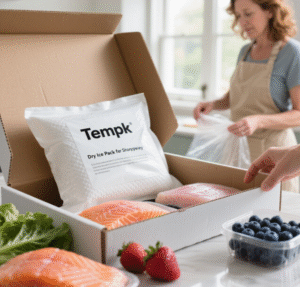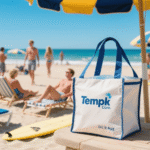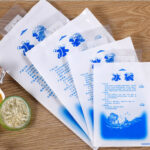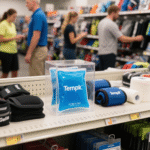Dry Ice Pack for Shipping Food (2025): Sicher, Compliant & Cost‑Smart
-
What dry ice packing is—and why it works
-
How much dry ice you really need (calculator + examples)
-
Step‑by‑step pack‑out that passes audits
-
2025 regulations cheat sheet (IATA/DOT/USPS)
-
Sicherheit: PPE, Belüftung & CO₂ exposure
-
Dry ice vs. gel packs vs. PCMs/VIPs
-
Food‑specific tips: Fleisch, Eiscreme, Meeresfrüchte
-
FAQs
Was dry ice packing is—and why it works
Dry ice is solid CO₂ that sublimates at –78.5 °C (–109.3 °F), so it keeps loads frozen without meltwater. As it sublimates, it displaces air with dense CO₂ gas; Verpackung must be able to vent.
Key physics for planners
-
Gas volume: ~8.8 ft³ CO₂ per lb of dry ice; sublimation rate depends on format (pellet vs. Block), Isolierung, and ambient profile.
-
Top‑loading helps: CO₂ sinks, so placing dry ice above the payload improves envelope temperature uniformity.
How much dry ice you really need
Rule‑of‑thumb starting point: 5–10 lb per 24 h in a typical insulated shipper, plus one extra day as a delay buffer; then validate with a data logger on your lane.
Lane‑aware calculator (pragmatic, not regulatory)
Start load = (5–10 lb × hours/24) × Insulation factor × Ambient factor + one 24 h base load as buffer.
-
Insulation factor: VIP × 0.7 · EPS (1–1.5″) × 1.0 · Minimal insulation × 1.3
-
Ambient factor: Mild (<25 °C) × 1.0 · Hot (25–35 °C) × 1.2 · Very hot (>35 °C) × 1.4
Beispiel (48 h, EPS, ~30 °C): (5–10 lb × 2)×1.0×1.2 + (5–10 lb) ≈ 17–34 lb. Validate before scale‑up.
Why this range works: It reflects widely cited operational guidance and real‑world thermal behavior; still, validate on your specific shipper and lane.
Step‑by‑step pack‑out that passes audits
-
Choose the right shipper. EPS for cost; VIP for long lanes/weight savings—ideally validated to ISTA 7E (72/144 h) with Standard 20 documentation.
-
Pre‑chill payload. Freeze to ≤0 °F (–18 °C) before packing for frozen shipments.
-
Line & segregate. Keep sensitive items off direct contact with dry ice.
-
Add dry ice (top‑load preferred) Und fill voids to reduce air exchange (slower sublimation).
-
Ensure venting. Never seal airtight; permit CO₂ release. (Required by DOT for air/water; also in IATA PI 954.)
-
Close, then mark & Etikett:
-
Proper shipping name: “Carbon dioxide, solid” or “Dry ice”, UN 1845
-
Net weight of dry ice in kilograms on each package
-
Class9 hazard label (diamond ≥100 mm)
-
-
Docs: For air consignments with only dry ice + non‑dangerous goods, A Shipper’s Declaration is not required; include the required text on the Air Waybill. Always honor state/operator variations.
2025 regulations cheat sheet (quick‑ref)
-
IATA DGR 66th (effective Jan 1, 2025):
-
≤200 kg dry ice per package by air; PI 954 requires vented packaging; AWB must list UN1845, proper name, number of packages, Und net kg. Operator variations apply.
-
-
U.S. PUNKT (49 CFR 173.217):
-
Packaging must permit CO₂ release to avoid rupture; mark net mass externally for aircraft; shipper must arrange with operator.
-
2.5 kg (5.5 lb) per package exception for certain air shipments if marked as specified (still vent!).
-
-
USPS (Postal Explorer):
-
International mail: prohibited.
-
Domestic air: ≤5 lb of dry ice per mailpiece; follow Packaging Instruction 9A.
-
-
Carrier guides (example FedEx):
-
Class 9 label ≥100×100 mm; UN 1845 text and net kg required; many carriers echo ≤200 kg per package consistent with IATA.
-
Practical takeaway: Bookings sometimes require declaring net kg at time of tender to ensure aircraft CO₂ limits aren’t exceeded (operator variations).
Sicherheit: PPE, Belüftung & CO₂ exposure
-
People: Use insulated gloves and eye protection; handle in well‑ventilated spaces.
-
Exposure limits: OSHA PEL = 5,000 ppm (8‑h TWA); NIOSH STEL = 30,000 ppm (15 min). Consider CO₂ monitors in pack rooms, coolers, und Fahrzeuge.
-
Vent awareness: 1 lb → ~8.8 ft³ CO₂; staging many boxes in a small room can spike CO₂—use exhaust, open doors, and limit batch size.
Dry ice vs. gel packs vs. PCMs/VIPs (which to choose?)
-
Trockeneis: Deep‑frozen/ultracold; strict marks/labels; heavier than some VIP+PCM combos.
-
Gelpackungen (water‑based): Best for 2–8 ° C; simpler compliance; possible condensate/leaks.
-
PCMs + VIP shippers: Tune setpoints (Z.B., –21 °C or +5 °C); validated VIP systems cut refrigerant mass and total freight on 72–144 h lanes.
<Food‑specific tips (Fleisch, Eiscreme, Meeresfrüchte)
-
Eiscreme: Aim to keep < –20 °C end‑to‑end; prefer VIP on 72 h lanes; top‑load dry ice; minimize headspace.
-
Meat/seafood: Pre‑freeze hard; use liners to avoid direct contact; consider pellets + blocks for faster start and longer tail.
-
Ops: Weekends add risk—ship early week Und add a full‑day buffer.
FAQs
How much dry ice for 48 h?
Start with 10–20 lb depending on shipper and lane, plus a 24‑h buffer; verify with pilots and a data logger.
Do I need a Shipper’s Declaration for dry ice?
If dry ice is the nur dangerous good and it’s cooling non‑dangerous goods by air, no Shipper’s Declaration is required; include the proper AWB text and labels. Carrier variations may add requirements.
Is dry ice allowed in international mail?
NEIN. USPS prohibits dry ice in international mail; domestic air is ≤5 lb with Packaging Instruction 9A.
Can I seal dry ice inside a bag?
No—packaging must vent; never airtight.
What are the safe exposure limits?
OSHA 5,000 ppm (TWA); NIOSH 30,000 ppm (STEL). Use monitors in small rooms
























